Worked out examples
Ex 1:
Find the square root of 341056.
Step 1:
Place a bar over every pair of digits starting from the unit's digit 

Step 2:
Find the largest number whose square is less
than or equal to the number under the left – most bar (5 2 < 34
< 6 2).
Take the number as the divisor and the number under the
left-most bar as the dividend.
Divide and get the remainder.
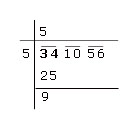
Thus,
Dividend = 34, divisor = 5, quotient = 5, remainder = 9
Step 3:
Bring down the number under the next bar to the right of the remainder.
This is the new
dividend.
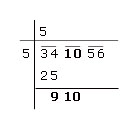
Thus, dividend = 910
Step 4:
Double the quotient(5) and enter it with a blank on the right for the next digit of the next possible divisor.
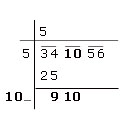
Step 5:
Guess the largest possible digit to fill the blank and become the new digit in the quotient.
Here the largest digit is 8 and the number is 108.
Take the number as the divisor and the number under the left-most bar as the dividend.
Divide and get the remainder.
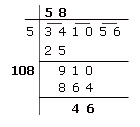
Here: Dividend = 910, divisor = 108, quotient = 58, remainder = 46
Step 6:
Bring down the number under the next bar to the right of the new remainder.
This is the new dividend.
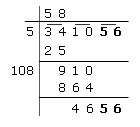
Thus, dividend = 4656
Step 7:
Double the quotient (58) and enter it with a blank on the right for the next digit of the next possible divisor.
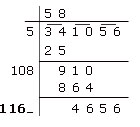
Step 8:
Guess the largest possible digit to fill the blank and become the new digit in the quotient.
Here the largest digit is 4, and the number is 1164
Take the number as the divisor and the number under the left-most bar as the dividend.
Divide and get the remainder.
Dividend = 4656, divisor = 1164, quotient = 584, remainder = 0
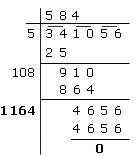
quotient = 584, remainder = 0

 = 584
= 584
Ex :
Find the square root of 687241?
Sol:
Given number is 687241
We follow the same procedure as above to find the square root of 687241.
Step 1 :
Place a bar over every pair of digits starting from the unit's digit

Step 2 :
Find the largest number whose square is less than or equal to the number under the
left-most bar (8 2 < 68 < 9 2).
Take the number as the divisor and the number under the left-most bar as the dividend.
Divide and
get the remainder.
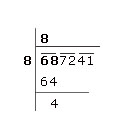
Thus,
Dividend = 68, divisor = 8, quotient = 8, remainder = 4
Step 3:
Bring down the number under the next bar to the right of the remainder.
This is the new
dividend.
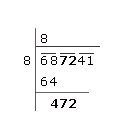
Thus, dividend = 472
Step 4:
Double the quotient (8) and enter it with a blank on the right for the next digit of the next
possible divisor.
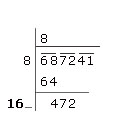
Step 5 :
Guess the largest possible digit to fill the blank and become the new digit in the quotient.
Here the largest digit is 2, and the number is 162
Take the number as the divisor and the number under the left-most bar as the dividend.
Divide and get the remainder.

Thus, Dividend = 472, divisor = 162, quotient = 82, remainder = 148
Step 6:
Bring down the number under the next bar to the right of the new remainder.
This is the new dividend.

Thus, dividend = 14841
Step 7:
Repeat steps 4, 5 and 6 till all bars have been considered.
The final quotient is the
square root.
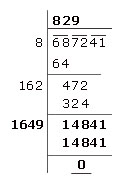
quotient = 829, remainder = 0

 = 829
= 829 Ex :
Find the square root of (i) 729 (ii) 8281?
Sol :
We follow the same as above:
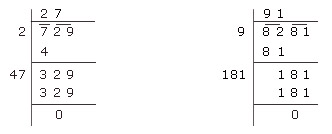

 = 27 and
= 27 and  = 91
= 91Ex :
Find the least number that must be subtracted from 4861 to get a perfect square.
Sol :
Thus, if we subtract 100 from 4861,
we get a perfect square number (whose square root is 69).
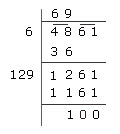
 4861 – 100 = 4761, which is a square of 69
4861 – 100 = 4761, which is a square of 69